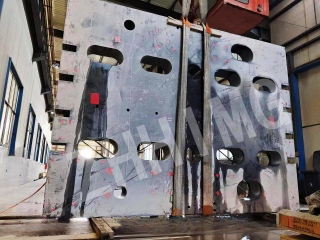Precision granite has been widely used in various industries due to its superior properties and benefits. One of the industries that have extensively utilized precision granite is the semiconductor and solar industry. In this article, we will discuss the advantages and disadvantages of precision granite in the semiconductor and solar industry.
Advantages of Precision Granite in the Semiconductor and Solar Industry
1. High Dimensional Stability
The semiconductor and solar industry require high precision and accuracy in their production processes. Precision granite provides high dimensional stability, which allows for the manufacturing of precise and accurate components. The granite's stability prevents deformation or warping due to temperature changes or heavy loads, resulting in consistent and reliable measurements.
2. Wear Resistance
Precision granite has a high resistance to wear and tear, making it ideal for use in semiconductor and solar industries. The semiconductor industry uses precision granite as a wafer stage material due to its ability to resist abrasion from the material handling systems. It also ensures that the wafers are placed in exact positions and maintain stability throughout the manufacturing process.
3. High Strength and Durability
Precision granite is known for its high strength and durability, making it suitable for long-term use. This property is valuable in the semiconductor and solar industry, where the tools and equipment require stable support and long-lasting use. Precision granite tools do not require frequent maintenance, thus reducing downtime and overall costs.
4. Resistant to Corrosion
Semiconductor and solar industries use corrosive chemicals that can corrode many materials. However, granite is resistant to corrosion and can withstand exposure to harsh chemicals and solvents, making it an ideal material for manufacturing equipment and tools.
5. Minimal Thermal Expansion
Precision granite has low thermal expansion, making it an ideal material for semiconductor and solar industries, where consistent thermal conditions are essential. The granite's low coefficient of thermal expansion ensures that the equipment and components remain stable and consistent under different temperature conditions.
Disadvantages of Precision Granite in the Semiconductor and Solar Industry
1. Expensive Material
Precision granite is an expensive material compared to other alternatives. It requires high-quality raw material, specialized manufacturing processes, and precision machining, which increases the overall cost.
2. Heavyweight
Granite is a heavyweight material, making it difficult to transport and maneuver. It requires expensive equipment and machinery to move and place the granite materials, which increases operational costs.
3. Brittle
Although precision granite has high strength and wear resistance, it is still a brittle material. Any significant impact or shock can cause cracks or fractures, resulting in the need for costly replacement or repair.
4. Time-Consuming Installation
Precision granite requires precise installation and calibration, which can be time-consuming and expensive. This installation process involves a high level of accuracy, which can result in significant delays and production downtime.
Conclusion
Precision granite has become a popular material choice in the semiconductor and solar industry due to its high dimensional stability, wear resistance, strength, and durability. Its resistance to corrosion and minimal thermal expansion ensure the products and equipment have long-term stability and consistency. Although there are disadvantages to using precision granite, such as the high cost, heavyweight, brittle nature, and time-consuming installation, the benefits outweigh the disadvantages. Therefore, precision granite remains a valuable material for the semiconductor and solar industry and will continue to be an essential material for manufacturing equipment and tools.
Post time: Jan-11-2024

